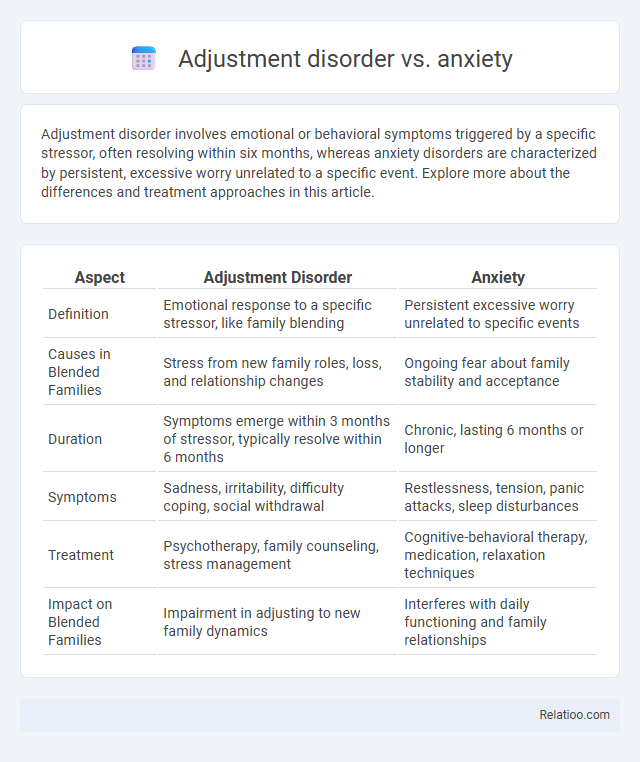Adjustment disorder involves emotional or behavioral symptoms triggered by a specific stressor, often resolving within six months, whereas anxiety disorders are characterized by persistent, excessive worry unrelated to a specific event. Explore more about the differences and treatment approaches in this article.
Table of Comparison
| Aspect | Adjustment Disorder | Anxiety |
|---|---|---|
| Definition | Emotional response to a specific stressor, like family blending | Persistent excessive worry unrelated to specific events |
| Causes in Blended Families | Stress from new family roles, loss, and relationship changes | Ongoing fear about family stability and acceptance |
| Duration | Symptoms emerge within 3 months of stressor, typically resolve within 6 months | Chronic, lasting 6 months or longer |
| Symptoms | Sadness, irritability, difficulty coping, social withdrawal | Restlessness, tension, panic attacks, sleep disturbances |
| Treatment | Psychotherapy, family counseling, stress management | Cognitive-behavioral therapy, medication, relaxation techniques |
| Impact on Blended Families | Impairment in adjusting to new family dynamics | Interferes with daily functioning and family relationships |
Understanding Adjustment Disorder
Adjustment disorder is a stress-related condition triggered by significant life changes or stressful events, causing emotional or behavioral symptoms that disrupt daily functioning. Unlike generalized anxiety disorder, which involves persistent and excessive worry unrelated to specific stressors, adjustment disorder symptoms typically resolve once the stressor is removed or the individual adapts. Understanding adjustment disorder helps you recognize that timely intervention and coping strategies can effectively manage symptoms before they escalate into chronic anxiety or depression.
Defining Anxiety Disorders
Anxiety disorders are characterized by excessive fear, worry, and behavioral disturbances that interfere with daily functioning. Adjustment disorder involves emotional or behavioral symptoms in response to a specific stressor, while anxiety disorders persist beyond the triggering event and often include panic attacks or generalized anxiety. Your understanding of anxiety disorders is crucial for distinguishing them from adjustment disorders and seeking appropriate treatment.
Key Symptoms: Adjustment Disorder vs Anxiety
Adjustment disorder primarily involves emotional or behavioral symptoms triggered by a specific stressor, such as sadness, hopelessness, or difficulty functioning. Anxiety disorder symptoms include excessive worry, restlessness, muscle tension, and physical signs like rapid heartbeat. Understanding your key symptoms helps differentiate adjustment disorder, which is stressor-related and time-limited, from anxiety disorders with persistent, often generalized symptoms.
Causes and Triggers
Adjustment disorder often arises from identifiable stressors such as major life changes, relationship difficulties, or work-related issues, whereas anxiety disorders may stem from genetic predispositions, brain chemistry imbalances, or prolonged stress exposure. Your adjustment disorder triggers are typically external events that disrupt your ability to cope, contrasting with anxiety triggers that can be internal fears or irrational worries not always linked to specific situations. Understanding these cause distinctions helps tailor effective treatment strategies for both adjustment disorder and anxiety.
Diagnostic Criteria Differences
Adjustment disorder is characterized by emotional or behavioral symptoms developing within three months of an identifiable stressor, whereas anxiety disorders involve excessive, persistent worry or fear not necessarily linked to a specific event. The Diagnostic and Statistical Manual of Mental Disorders (DSM-5) specifies that adjustment disorder symptoms are disproportionate to the stressor and cause significant impairment but do not meet criteria for another mental disorder like generalized anxiety disorder or panic disorder. Your diagnosis depends on symptom duration, context, and whether symptoms align more closely with stress-related maladjustment or pervasive anxiety patterns.
Duration and Course of Each Condition
Adjustment disorder typically emerges within three months of a significant stressor and generally resolves within six months after the stressor or its consequences end. Anxiety disorders, including generalized anxiety disorder, often persist for six months or longer and tend to have a chronic or recurrent course without timely treatment. Adjustment disorder symptoms are usually shorter in duration and less pervasive compared to the prolonged and impairing nature of anxiety disorders.
Impact on Daily Functioning
Adjustment disorder primarily disrupts your ability to cope with specific stressors, causing emotional or behavioral symptoms that impair daily functioning but often improve once the stressor is removed. Anxiety disorders generate persistent, excessive worry or fear that interferes with concentration, sleep, and social interactions, significantly impacting work, relationships, and overall productivity. Unlike generalized anxiety, adjustment disorder symptoms are typically time-limited and directly linked to an identifiable event, whereas anxiety disorders may persist independently of external stressors.
Treatment Approaches Compared
Treatment approaches for adjustment disorder primarily involve psychotherapy, such as cognitive-behavioral therapy (CBT) and stress management techniques, aimed at helping individuals cope with specific stressors. Anxiety disorders often require a combination of CBT, medication like selective serotonin reuptake inhibitors (SSRIs), and lifestyle adjustments to manage generalized symptoms and prevent escalation. While adjustment disorder treatment targets situational stress with short-term therapy, anxiety disorder treatment typically includes long-term strategies addressing chronic symptoms and may involve pharmacotherapy.
When to Seek Professional Help
You should seek professional help if symptoms of adjustment disorder persist beyond six months, interfere with daily functioning, or worsen despite self-management efforts. Anxiety disorders require attention when excessive worry causes physical symptoms such as rapid heartbeat or panic attacks, or disrupts your social and occupational life. Early intervention by a mental health professional ensures proper diagnosis and tailored treatment for both adjustment disorder and anxiety, improving long-term outcomes.
Prevention and Coping Strategies
Effective prevention and coping strategies for adjustment disorder and anxiety include maintaining regular physical activity, practicing mindfulness techniques, and ensuring a strong social support system. Early identification through mental health screenings and stress management programs can reduce symptom severity and improve resilience. Cognitive-behavioral therapy (CBT) and relaxation exercises are evidence-based approaches that help manage emotional distress and promote adaptive coping skills.

Infographic: Adjustment disorder vs Anxiety
 relatioo.com
relatioo.com